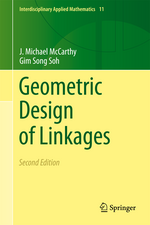Walking Machines: An Introduction to Legged Robots: Chapman and Hall Advanced Industrial Technology Series
Autor D. J. Todden Limba Engleză Paperback – 19 mar 2012
Preț: 382.18 lei
Nou
Puncte Express: 573
Preț estimativ în valută:
73.13€ • 79.69$ • 61.62£
73.13€ • 79.69$ • 61.62£
Carte tipărită la comandă
Livrare economică 23 aprilie-07 mai
Preluare comenzi: 021 569.72.76
Specificații
ISBN-13: 9781468468601
ISBN-10: 146846860X
Pagini: 192
Ilustrații: 190 p.
Dimensiuni: 155 x 235 x 10 mm
Greutate: 0.28 kg
Ediția:Softcover reprint of the original 1st ed. 1985
Editura: Springer Us
Colecția Springer
Seria Chapman and Hall Advanced Industrial Technology Series
Locul publicării:New York, NY, United States
ISBN-10: 146846860X
Pagini: 192
Ilustrații: 190 p.
Dimensiuni: 155 x 235 x 10 mm
Greutate: 0.28 kg
Ediția:Softcover reprint of the original 1st ed. 1985
Editura: Springer Us
Colecția Springer
Seria Chapman and Hall Advanced Industrial Technology Series
Locul publicării:New York, NY, United States
Public țintă
ResearchCuprins
Advantages of legs.- Terminology.- 1 A brief history of walking machines.- Rough-terrain transport.- Bipeds: medical applications and man-amplifiers.- The modern era: computer control.- Alternative mechanisms of locomotion.- 2 General principles of legged locomotion.- The theory of land locomotion in general.- The soil mechanics of wheels.- Locomotion using levers.- Soil mechanics and the difference between feet and wheels.- The energetics of legged locomotion.- Other properties of legs.- Mechanisms other than legs.- Aids to locomotion.- Non-locomotory uses of appendages.- Description and classification of gaits.- 3 The mechanics of legged vehicles.- Animal structures and their applications to robots.- Leg number and arrangement.- Leg design.- Structure.- Actuation methods.- 4 The analysis and control of legged systems.- Purpose of analysis and control.- The objectives of control in legged locomotion.- Dynamics.- Multipod control.- 5 Computing: hardware and software requirements.- Computer architectures.- Sensing methods.- The design of algorithms for multipod walking.- Programming languages for legged robots.- 6 Current developments.- The Ohio State University hexapod and adaptive suspension vehicle.- ReCUS: the Komatsu underwater octopod.- Sutherland’s hexapod.- The Odetics ODEX I.- Quadruped research at the Tokyo Institute of Technology.- Walking robots in France.- Jurassic Robots.- Current research on bipeds.- Research on hopping at Carnegie-Mellon University.- Conclusions.- 7 Applications of walking machines.- Military transport.- Mining.- Nuclear engineering and other cases of remote handling.- Prosthetics and orthotics: walking chairs.- Planetary exploration.- Construction and related activities.- Agriculture and forestry.- Mobile robots in artificialintelligence.- Fire-fighting and rescue robots.- Applications unlikely to be suitable for walking machines.- The study of locomotion (zoology and engineering).- Education, art and entertainment.- References and bibliography.




















